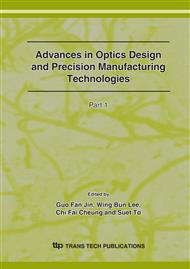p.1089
p.1095
p.1100
p.1105
p.1111
p.1117
p.1123
p.1128
p.1133
Key Issues in Measuring the Velocities of Nanoparticles in Nanofluids
Abstract:
Our recent work [1] theoretically revealed that speckles can be formed when nanofluids containing a modest volume fraction of nanoparticles are illuminated by a monochromatic laser beam. This paper focuses on the key issues, including the experimental setup, the particle volume fraction of the nanofluid, the flow velocity of the nanofluid and the diameter of the pipe, in measuring the velocities of nanoparticles in nanofluids with laser speckle velocimetry (LSV). First an experimental setup is established according to the optical characteristics of nanoparticle and the measuring principles of particle image velocimetry (PIV) and LSV. Then a conclusion is made from the experimental results that clear speckle patterns can be formed when the particle volume fraction is between 0.0005% and 0.002% is able to form. Finally, in order to make it applicable to utilize LSV to measure the velocities of nanoparticles in nanofluids that flow in pipe, nanofluids can not flow too fast and the diameter of the pipe should not be too small.
Info:
Periodical:
Pages:
1111-1116
Citation:
Online since:
December 2007
Authors:
Keywords:
Price:
Сopyright:
© 2008 Trans Tech Publications Ltd. All Rights Reserved
Share:
Citation:


